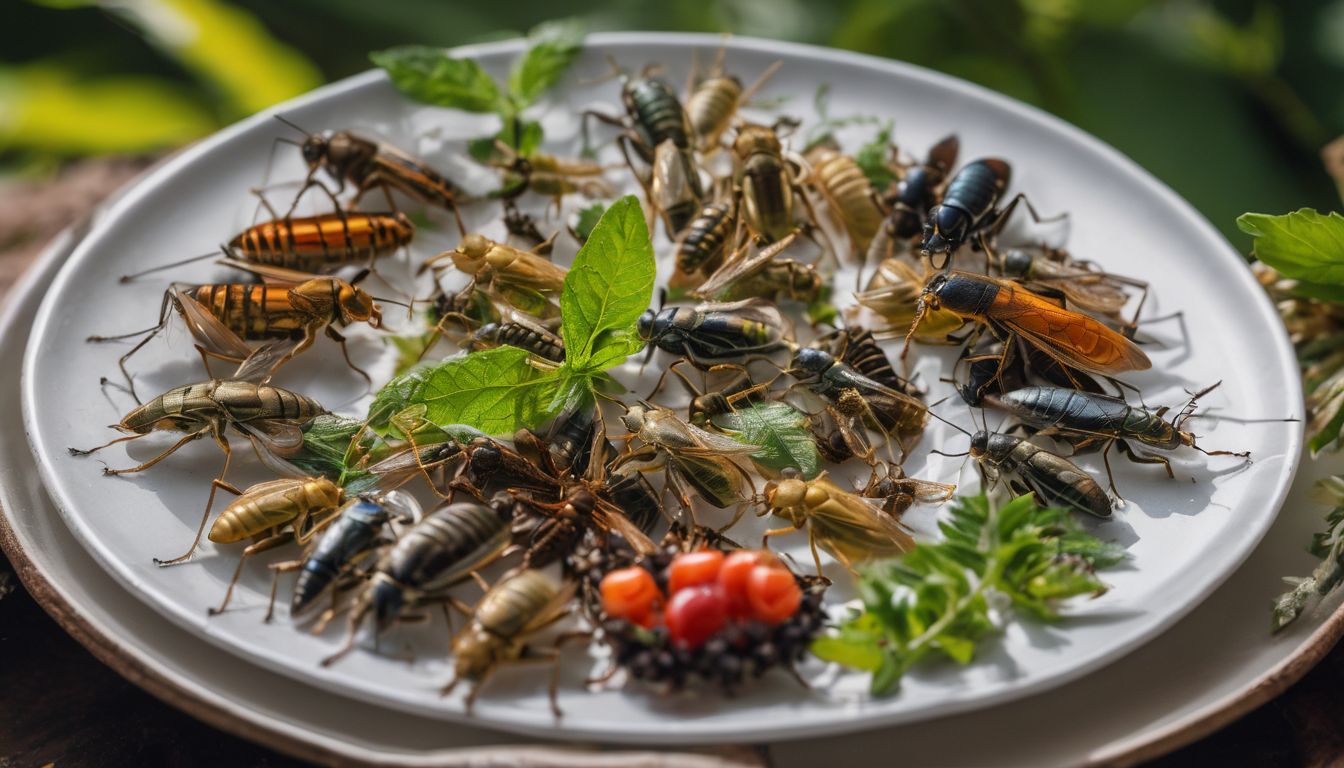Struggling with meal times and fussy eaters is a daily battle for many parents. Research has shown that good nutrition is crucial in children’s early years, affecting everything from growth to cognitive development.
Our guide offers practical advice on creating a nutritious diet that keeps kids healthy and happy, without the stress. “Read on; your journey to peaceful dinners starts here!”.
Key Takeaways
- Children’s nutrition significantly influences their health, growth, and cognitive development. It’s essential to create a well-balanced diet with fruits, vegetables, whole grains, healthy proteins, and dairy or fortified alternatives.
- Introducing various foods from an early age helps children develop diverse palates and good eating habits that can prevent chronic illnesses like obesity and type 2 diabetes later in life.
- Involving kids in meal planning, preparation, and making smart food choices teaches them about nutrition and encourages them to try new foods while supporting sustainable practices.
- Healthy snacks should be easily accessible for children between meals. This promotes better food choices that are nutritious rather than reaching for processed options.
- Setting a positive example by consuming balanced diets and staying active is crucial as parents’ habits directly influence their children’s behaviours towards food and exercise.
Importance of Healthy Eating for Children
Healthy eating is crucial for children’s health, development, and long-term well-being. It plays a vital role in supporting their growth and providing essential nutrients for overall health.
Impact on Children’s Health
Eating a nutritious diet plays a critical role in children’s overall health and wellbeing. Good nutrition helps little bodies fight off illness, maintain energy levels, and supports brain development.
When kids eat balanced meals that include fruits, vegetables, and whole grains, they are more likely to have strong bones and muscles. Moreover, teaching children about healthy eating can lead to better food choices that prevent issues like obesity or type 2 diabetes.
Children who learn about the importance of healthy food early on are equipped to make smarter decisions for their future. A child’s balanced nutrition should be prioritised as it directly affects their physical growth and cognitive abilities.
Not only does this foster a healthier lifestyle but also instils values of conservation and respect for the environment through choices like local produce consumption.
Next up is understanding how these choices play a part in “Role in Development and Growth”.
Role in Development and Growth
Children’s healthy eating habits play a crucial role in their overall development and growth. A well-balanced diet provides essential nutrients needed for physical, mental, and emotional development.
Nutritious meals help children maintain a healthy weight, support bone and muscle growth, improve cognitive function, and strengthen the immune system. Furthermore, encouraging children to eat a variety of fruits, vegetables, whole grains, lean proteins, and dairy products fosters good eating habits that can be carried into adulthood.
By instilling healthy eating practices from an early age, parents and caregivers contribute to laying the foundation for lifelong wellbeing in children.
Long-term Health Benefits
Encouraging children to develop healthy eating habits early on can lead to a lifetime of positive health outcomes. A balanced and nutritious diet during childhood sets the stage for reduced risk of chronic diseases such as obesity, type 2 diabetes, and heart disease later in life.
It also supports optimal bone health, cognitive function, and overall wellbeing, laying a strong foundation for a vibrant and active future.
By promoting healthy eating practices in children from an early age, caregivers play a crucial role in shaping their long-term health trajectory. By integrating whole foods into their daily meals and snacks, parents contribute to their offspring’s physical resilience and mental acuity well into adulthood.
Creating an environment that fosters healthy dietary choices reaps lasting benefits that extend far beyond childhood years.
Building a Balanced Diet for Children
Creating a balanced diet for children involves including a variety of foods from each food group, such as fruits, vegetables, whole grains, healthy sources of protein, and dairy. It’s important to focus on providing nutritious options to support their growth and development.
Include a Variety of Foods from Each Food Group
To promote a balanced diet for children, it is essential to include a variety of foods from each food group. This ensures that they receive a wide range of nutrients and minerals necessary for their growth and development.
- Fruits and Vegetables: Incorporate a colorful array of fruits and vegetables into meals to provide essential vitamins, minerals, and dietary fiber.
- Whole Grains: Opt for whole grain options such as whole wheat bread, brown rice, oats, and quinoa to supply complex carbohydrates and fiber.
- Healthy Proteins: Choose lean meats, poultry, fish, eggs, nuts, seeds, and legumes as healthy sources of protein for muscle growth and repair.
- Dairy or Fortified Alternatives: Include dairy products like milk, yogurt, and cheese or fortified plant-based alternatives for calcium and vitamin D.
Encourage Fruits, Vegetables, and Whole Grains
Encouraging children to eat fruits, vegetables, and whole grains can be achieved in various ways. Here are some effective strategies for promoting healthy eating habits in children:
- Get creative with presentation: Cut fruits and vegetables into fun shapes or arrange them in a colourful way to make them more appealing.
- Let kids choose: Involve children in picking out fruits and vegetables at the store or farmer’s market. This can increase their enthusiasm for trying new produce.
- Experiment with recipes: Introduce different ways of preparing fruits, vegetables, and whole grains to keep meals interesting and flavorful.
- Grow a garden: Engage children in planting and caring for a small vegetable or fruit garden, allowing them to witness the process from seed to plate.
- Incorporate variety: Offer a wide range of fruits, vegetables, and whole grains across different meals to expose children to diverse tastes and textures.
- Educate about benefits: Explain the importance of these foods for health, energy, and overall well-being to encourage positive attitudes towards them.
- Lead by example: Demonstrate your enjoyment of fruits, vegetables, and whole grains by including them in your own diet regularly.
Choosing Healthy Sources of Protein
Encourage Fruits, Vegetables, and Whole Grains to lay the foundation for a balanced diet rich in nutrients. When considering protein options for children, opt for lean meat like turkey or chicken without the skin.
Introduce plant-based proteins such as beans, lentils, and tofu into their meals to provide essential amino acids while supporting sustainable food choices.
Explore more diverse sources of protein such as fish – a great way to include heart-healthy omega-3 fatty acids in your child’s diet. Consider incorporating nuts and seeds into snacks or meals to offer healthy fats and vital nutrients.
Importance of Dairy and Fortified Alternatives
After focusing on choosing healthy sources of protein, it’s essential to understand the importance of including dairy and fortified alternatives in a child’s diet. These options provide essential nutrients like calcium, vitamin D, and protein that are crucial for children’s bone health and overall growth.
Fortified plant-based milk alternatives can be particularly beneficial for environmentally conscious individuals, as they offer similar benefits to traditional dairy products while also being more sustainable.
By incorporating these options into a child’s diet, parents can ensure that their children receive the necessary nutrients for healthy development.
Tips for Encouraging Healthy Eating in Children
Ensure that nutritious snacks are readily available and involve children in meal planning and preparation. Set a good example by making healthy food choices and avoid making mealtimes a battleground.
Keep Nutritious Snacks on Hand
Make sure to have a variety of healthy snacks readily available for your children. This will help them make better food choices and satisfy their hunger between meals. When you have nutritious snacks on hand, such as fresh fruit, cut-up vegetables, yoghurt, or whole-grain crackers, it makes it easier for your kids to reach for something healthy when they need a snack.
Encouraging the consumption of nutrient-dense snacks also supports sustainable food choices and reduces the carbon footprint associated with processed and packaged goods. By providing easy access to wholesome options like nuts, seeds, and locally sourced produce—instead of single-use plastic-wrapped items—you can instill eco-friendly eating habits in your children from an early age.
Involve Children in Meal Planning and Preparation
After keeping nutritious snacks on hand, involve children in meal planning and preparation to empower them with healthy eating habits.
- Encourage kids to pick out fruits and vegetables they want to include in the meals during grocery shopping trips, supporting their connection to food choices and decision-making.
- Assign simple tasks like washing produce, tearing lettuce for a salad, or stirring ingredients to involve them in meal preparation and build their confidence in the kitchen.
- Show children how to read recipes and measure ingredients while explaining the importance of following instructions for balanced and nutritious meals.
- Have discussions about the benefits of different foods they are helping prepare, linking them to the environmental impact of various food choices.
Be a Role Model
Demonstrate healthy eating habits to your children by including a variety of fruits, vegetables, whole grains, and lean proteins in your meals. Show enthusiasm for nutritious foods and maintain a positive attitude towards trying new dishes.
Participate in physical activities regularly and involve the family in fun outdoor adventures to emphasise the importance of staying active.
Encourage environmentally friendly practices such as purchasing locally sourced produce and reducing food waste to instil eco-conscious values in your children. Engage them in gardening or cooking with fresh ingredients to develop an appreciation for nature and sustainable living while promoting healthy eating habits.
Avoid Battles Over Food
Encourage positive eating habits by providing a variety of nutritious foods and involving children in meal planning. Offer choices within healthy options, allowing children to select their preferences within these boundaries.
By being consistent with meals and snacks, kids will learn to trust that nourishing food is always available.
Promote independence through self-regulation; encourage children to listen to their bodies’ hunger cues and eat accordingly. Resist the urge to force or bribe them into finishing their meals or trying new foods, as this may lead to power struggles over food.
Dealing with Picky Eating
Encouraging Variety and Exploration: Help your child develop a love for different foods by offering a variety of options and encouraging exploration. To learn more about dealing with picky eating, read the full blog.
Strategies for Toddlers
To encourage healthy eating in toddlers, you can:
- Offer a variety of foods to expose them to different tastes and textures.
- Make mealtimes enjoyable by creating a calm and pleasant environment.
- Serve small portions and allow toddlers to explore and touch their food.
- Set regular meal and snack times to establish a routine.
- Limit distractions such as TV or electronic devices during meals.
Encouraging Variety and Exploration
To promote variety and exploration in children’s diets, try introducing new foods alongside familiar ones. Exposing children to a diverse range of flavours and textures can help expand their palate and encourage flexibility in food choices.
- Introduce a new fruit or vegetable each week, such as kiwi, bell peppers, or sugar snap peas. Encourage them to explore the new food through touch, smell, and taste.
- Experiment with different cooking methods for vegetables, like roasting, steaming, or grilling. This can bring out unique flavours and textures that may appeal to children.
- Incorporate global cuisines into meal planning to introduce new spices and ingredients. For example, make homemade sushi rolls or cook a simple curry dish together.
- Grow a small herb garden at home and involve children in caring for the plants. They can then use the herbs in cooking and experience the satisfaction of eating something they helped grow.
- Visit farmers’ markets or pick-your-own farms to expose children to seasonal produce and interact with local growers. This can foster an appreciation for fresh, locally sourced foods.
- Organise a “taste test” activity where kids can sample small portions of different fruits, vegetables, or whole grains and rate them based on flavour and texture.
Additional Resources and Tools
Discover helpful resources and tools, such as the Kid’s Healthy Eating Plate and tips for staying active with your children. For more information on healthy eating for children, read our blog to learn how to support your child’s nutritional needs.
Kid’s Healthy Eating Plate
Teaching children about healthy eating can be made simpler with the Kid’s Healthy Eating Plate. This tool provides a visual guide to help kids understand portion sizes and proportions of different food groups.
The plate is divided into sections for fruits and vegetables, whole grains, protein, and healthy fats, offering an interactive way to introduce balanced meals. Encouraging the use of the Kid’s Healthy Eating Plate at home or in educational settings can aid in promoting nutritious diet for children, supporting their growth and development while fostering healthy eating habits that will benefit them well into adulthood.
The Kid’s Healthy Eating Plate offers an engaging way to teach children about healthy food choices without overwhelming them with complex nutritional information. By incorporating this tool into their daily routine, parents and educators can play a crucial role in instilling good nutrition practices from an early age.
Coloring Books and Games
Coloring books and games can be powerful tools to educate children about healthy eating. They provide a fun and interactive way for kids to learn about different food groups, the importance of fruits and vegetables, and the benefits of a balanced diet.
By incorporating themes of nutrition and sustainability into these activities, children can develop a deeper understanding of how their food choices impact both their own health and the environment.
Engaging children with coloring books and games that feature nutritious foods, gardening activities, or environmental conservation can instill lifelong healthy habits while fostering an appreciation for nature.
Tips and Tools for Parents
After engaging your children in fun and educational activities with coloring books and games, it’s time to equip yourself with effective tools and strategies for promoting healthy eating. Here are some tips and tools for parents that will help create a supportive environment for your children:
- Involve children in meal planning and grocery shopping to teach them about nutritious food choices and get them excited about healthy options.
- Set a good example by enjoying balanced meals as a family, showing your kids the importance of making healthy food choices every day.
- Create a positive atmosphere during meal times by having relaxed conversations and avoiding forcing or pressuring your children to eat certain foods.
- Encourage physical activity alongside proper nutrition by planning active family outings, sports games, or nature walks to promote a holistic approach to health.
- Seek out reputable resources such as childhood nutrition guidelines, educational websites, or cookbooks focusing on child-friendly healthy recipes to expand your knowledge and keep mealtimes interesting for your children.
Childhood Nutrition Facts
Childhood nutrition facts are essential for promoting healthy eating habits in children. Understanding the nutritional requirements for kids is crucial to ensure they receive all the necessary nutrients for growth and development.
It’s important to focus on providing a balanced diet with a variety of foods from different food groups, including fruits, vegetables, whole grains, lean proteins, and dairy or fortified alternatives.
Encouraging children to consume nutritious snacks and meals while teaching them about MyPlate and healthy food choices can help set the foundation for a lifetime of good eating habits.
Promoting healthy eating in children also involves educating them about the importance of fruits and vegetables in their diet. Emphasising the benefits of including these foods as part of their daily meals can lead to an increased appreciation for nutritious options and contribute to overall well-being.
Government Guidelines for Children’s Nutrition
Government guidelines for children’s nutrition provide essential recommendations for promoting healthy eating habits and overall well-being in children. These guidelines emphasise the importance of providing a variety of nutrient-dense foods, including fruits, vegetables, whole grains, lean proteins, and low-fat dairy products.
They also highlight the significance of limiting added sugars, sodium, and saturated fats in a child’s diet to reduce the risk of chronic diseases and maintain a healthy weight.
By following these guidelines, parents can ensure that their children receive the necessary nutrients for growth and development while instilling lifelong healthy eating habits. Additionally, incorporating these recommendations into daily meal planning supports environmental sustainability by promoting locally sourced produce and sustainable farming practices.
Importance of Staying Active
Engaging in regular physical activity is crucial for children’s overall health and well-being. It helps build strong bones and muscles, improves cardiovascular fitness, and supports healthy growth and development.
Encouraging kids to stay active also fosters good mental health, boosts self-esteem, and helps them develop social skills through team sports or group activities. Additionally, staying active from a young age sets the foundation for a lifelong habit of exercise, promoting a healthy lifestyle as they grow older.
Regular physical activity ensures that children maintain a healthy weight, reducing the risk of obesity-related diseases in later life. It also stimulates cognitive function and academic performance while providing an opportunity to connect with nature through outdoor play or nature-based activities.
Conclusion
In conclusion, promoting healthy eating habits in children is crucial for their overall well-being. Encouraging balanced meals with a variety of nutritious foods from each food group plays a vital role in their development and growth.
By providing children with healthy options and involving them in meal planning, we can instill lifelong positive eating habits. It’s important to be mindful of the nutritional requirements for children and strive to create an environment that fosters a love for healthy foods and good nutrition.
FAQs
1. Why is a guide to healthy eating for children important?
A guide to healthy eating for children can teach them about balanced meals and nutritional guidelines, which are essential in promoting their overall health and growth.
2. How can we encourage kids to eat more fruits and vegetables?
By making fruits and vegetables a regular part of meals, offering them as snacks, and involving kids in choosing and preparing these nutritious foods, you can help foster healthy eating habits.
3. What does MyPlate teach children about healthy food choices?
MyPlate helps children understand the importance of including different food groups into their diet by showing them how to fill half their plate with fruits and vegetables alongside whole grains and lean proteins.
4. What kinds of snacks are considered healthy options for kids?
Healthy snack options for kids include whole fruit, veggie sticks with hummus, yogurt, or homemade popcorn without added sugar or salt – all contribute to a nutritious diet.
5. How do I plan a healthy meal for my child?
Start by selecting a variety of nutrient-rich foods from each food group according to nutritional requirements; aim at creating colorful plates filled with wholesome items like lean proteins, whole grains, fruits, veggies, and dairy.





